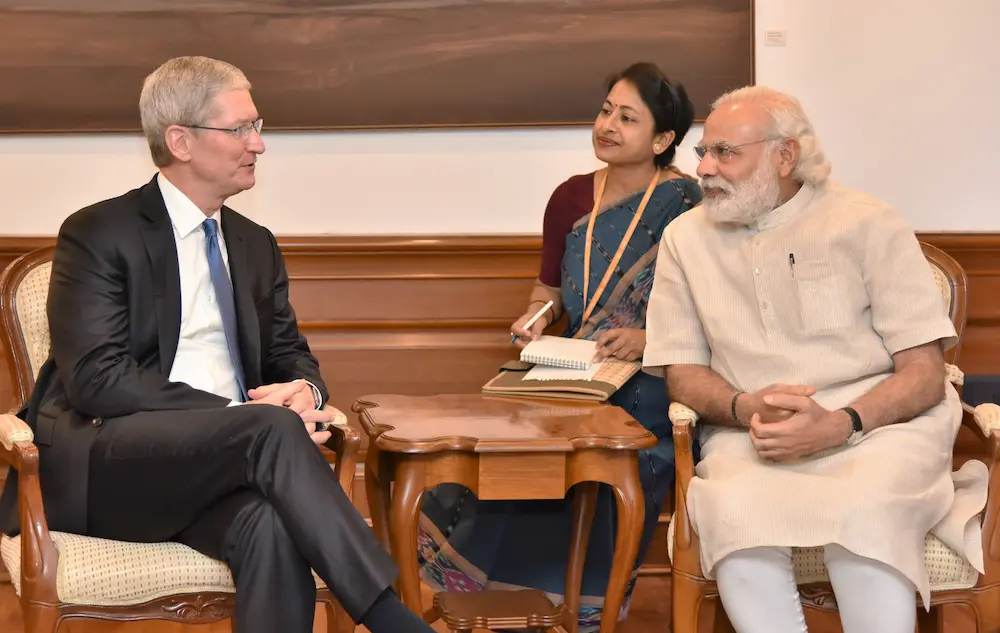
Apple finds itself at a crossroads between India’s rising promise and China’s entrenched dominance
Apple Inc Strategic Showdown – the world’s most valuable tech company, is facing a strategic inflection point that could redefine its global manufacturing footprint. At the heart of this dilemma lies a question that’s troubling not just Apple’s leadership but also economists and policymakers: Should Apple double down on China or pivot more aggressively toward India? According to University of Michigan economist Justin Wolfers, Apple CEO Tim Cook is spending more time navigating political landscapes than innovating, a shift that reflects the growing complexity of global trade and geopolitics.
The Geopolitical Undercurrent
Apple’s manufacturing strategy has long been anchored in China, where decades of investment have created a robust supply chain ecosystem. However, escalating trade tensions between the U.S. and China, particularly under President Donald Trump’s administration have forced Apple to reconsider its reliance on Chinese factories. Tariffs, political pressure, and the risk of supply chain disruptions have made diversification not just a strategic choice but a necessity.
India, with its growing economy, favourable demographics, and government incentives, has emerged as a compelling alternative. Yet, the transition is far from seamless.
India: The Rising Contender
India’s appeal lies in its potential to become a manufacturing powerhouse. Apple has already made significant strides, with Foxconn and Tata Electronics ramping up production in Tamil Nadu. In fact, Apple plans to source all iPhones sold in the U.S. from India by 2026, a move that underscores the seriousness of its diversification efforts.
During a recent earnings call, Tim Cook confirmed that more than half of iPhones sold in the US in the March quarter originated from India, marking a historic shift in Apple’s supply chain strategy. The company has also chartered cargo flights to expedite shipments from India, established green corridors for customs clearance, and added Sunday shifts to meet demand.
The China Conundrum
Despite India’s promise, China remains indispensable. Apple’s deep-rooted presence in China includes thousands of suppliers, highly skilled labour, and a mature infrastructure that India is still years away from replicating. As Patrick McGee, author of Apple in China, points out, India’s manufacturing ecosystem is still small and heavily dependent on Chinese components, making a full shift challenging.
Moreover, recent reports suggest that hundreds of Chinese engineers working at Foxconn’s Indian facilities have returned to China, potentially slowing down technology transfer and workforce training. While Apple insists that production schedules remain unaffected, the move highlights the fragility of India’s manufacturing readiness.
Political Capital vs. Innovation
Wolfers’ critique of Tim Cook’s leadership centres on what he calls “corny capitalism”, a system where CEOs are rewarded or punished based on their political relationships rather than innovation. He argues that Cook’s most pressing task is to “keep Trump happy,” a stark contrast to Steve Jobs’ singular focus on product excellence.
This shift in priorities reflects a broader trend in corporate America, where political appeasement increasingly influences strategic decisions. Apple’s tariff exemptions, lobbying efforts, and factory location choices are now intertwined with geopolitical calculations.
Economic Trade-Offs
From a cost perspective, manufacturing in India is not necessarily cheaper. A JPMorgan analysis cited by India Dispatch suggests that iPhones assembled in India cost about 2% more than those made in China, primarily due to logistics and supply chain inefficiencies. However, this is still far more economical than manufacturing in the U.S., which could raise costs by up to 30%.
Apple’s cautious approach reflects these trade-offs. While India offers lower tariffs and a growing consumer base, it lacks the scale and integration of China’s manufacturing ecosystem. For now, Apple is focusing on final assembly, testing, and packaging (FATP) in India, with most components still sourced from China.
India’s Market Potential
Beyond manufacturing, India represents a massive growth opportunity. With a burgeoning middle class and increasing smartphone penetration, Apple has set quarterly sales records in the country. The company plans to open more retail stores and expand its product offerings, including the rollout of Apple Intelligence features tailored for Indian users.
Yet, Apple’s market share in India remains modest. Competing with budget-friendly Android devices and navigating local sourcing requirements are ongoing challenges. Still, the upside is significant, and Apple is betting big on India’s long-term potential.
Apple Inc Strategic Showdown – What Lies Ahead?
Apple’s manufacturing dilemma is emblematic of the broader challenges facing multinational corporations in a polarized world. The choice between India and China is not binary, it’s a balancing act that requires agility, foresight, and diplomacy.
Tim Cook’s strategy appears to be one of gradual diversification, leveraging India for U.S.-bound products while maintaining China’s role for global sales. This dual-track approach allows Apple to hedge against geopolitical risks without sacrificing operational efficiency.
However, as trade tensions evolve and political pressures mount, Apple may be forced to accelerate its shift. The stakes are high not just for Apple’s bottom line but for the future of global manufacturing.
Final Thoughts
Apple’s journey from Cupertino to Chennai is more than a supply chain story, it’s a reflection of how innovation, politics, and economics intersect in today’s world. As Tim Cook navigates this complex terrain, the decisions he makes will shape not only Apple’s future but also the contours of global tech manufacturing.
And if you ask economists like Wolfers, the real question isn’t just where Apple builds its factories, it’s what kind of capitalism we’re building along the way.
Stay updated with the latest news on Rapido Updates. Keep yourself updated with The World, India News, Entertainment, Market, Automobile, Gadgets, Sports, and many more
Foxconn’s Strategic Exodus: China’s Grip Jeopardizes Apple’s Bold Manufacturing Bet in India
₹2.75 Lakh Crore at Risk: How China Export Denial Threaten India’s Manufacturing Ambitions
2 thoughts on “Apple Inc Strategic Showdown: The Fierce Battle Between Efficiency and Autonomy”
Comments are closed.